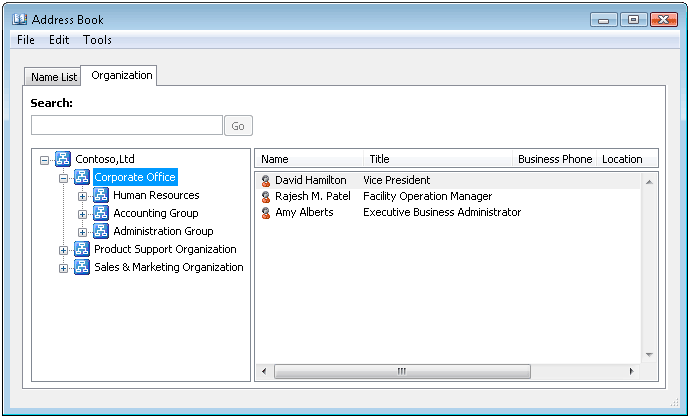Hierarchical address books in Exchange Server
Applies to: Exchange Server 2013
The hierarchical address book (HAB) allows users to look for recipients in their address book using an organizational hierarchy. Normally, users are limited to the default global address list (GAL) and its recipient properties and the structure of the GAL often doesn't reflect the management or seniority relationships of recipients in your organization. Being able to customize an HAB that maps to your organization's unique business structure provides your users with an efficient method for locating internal recipients.
Using hierarchical address books
In an HAB, your root organization (for example, Contoso, Ltd) is used as the top-level tier. Under this top-level tier, you can add several child tiers to create a customized HAB that's segmented by division, department, or any other organizational tier you want to specify. The following figure illustrates an HAB for Contoso, Ltd with the following structure:
The top-level tier represents the root organization Contoso, Ltd.
The second-level child tiers represent the business divisions within Contoso, Ltd: Corporate Office, Product Support Organization, and Sales & Marketing Organization.
The third-level child tiers represent departments within the Corporate Office division: Human Resources, Accounting Group, and Administration Group.

You can provide an additional level of hierarchical structure by using the SeniorityIndex parameter. When creating an HAB, use the SeniorityIndex parameter to rank individual recipients or organizational groups by seniority within these organizational tiers. This ranking specifies the order in which the recipients or groups are displayed in the HAB. For example, in the preceding example, the SeniorityIndex parameter for the recipients in the Corporate Office division is set to the following:
100for David Hamilton50for Rajesh M. Patel25for Amy Alberts
Note
If the SeniorityIndex parameter isn't set or is equal for two or more users, the HAB sorting order uses the PhoneticDisplayName parameter value to list the users in ascending alphabetical order. If the PhoneticDisplayName parameter value isn't set, the HAB defaults to the DisplayName parameter value and lists the users in ascending alphabetical order.
Configuring hierarchical address books
Detailed instructions for creating HABs are included in the topic Enable or disable hierarchical address books. The general steps are as follows:
Create a distribution group that will be used for the root organization (top-level tier). If desired, you can use an existing organizational unit in your Exchange forest for the distribution group.
Create distribution groups for the child tiers and designate them as members of the HAB. Modify the SeniorityIndex parameter of these groups so they're listed in the proper hierarchical order within the root organization.
Add organization members. Modify the SeniorityIndex parameter of the members so they're listed in the proper hierarchical order within the child tiers.
For accessibility purposes, you can use the PhoneticDisplayName parameter, which specifies a phonetic pronunciation of the DisplayName parameter, and is also used for the sort order if the SeniorityIndex parameter value isn't set.